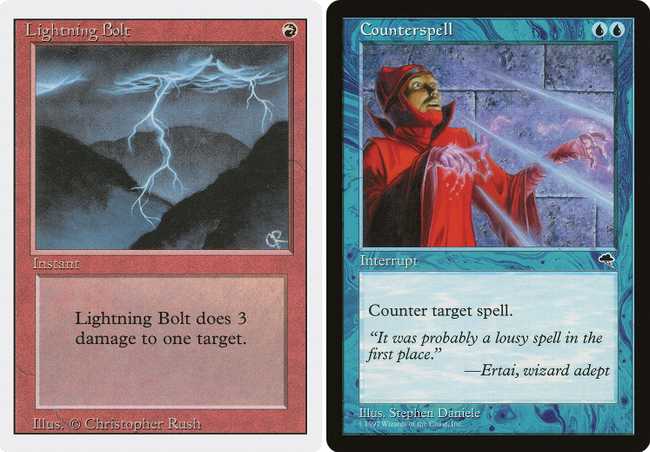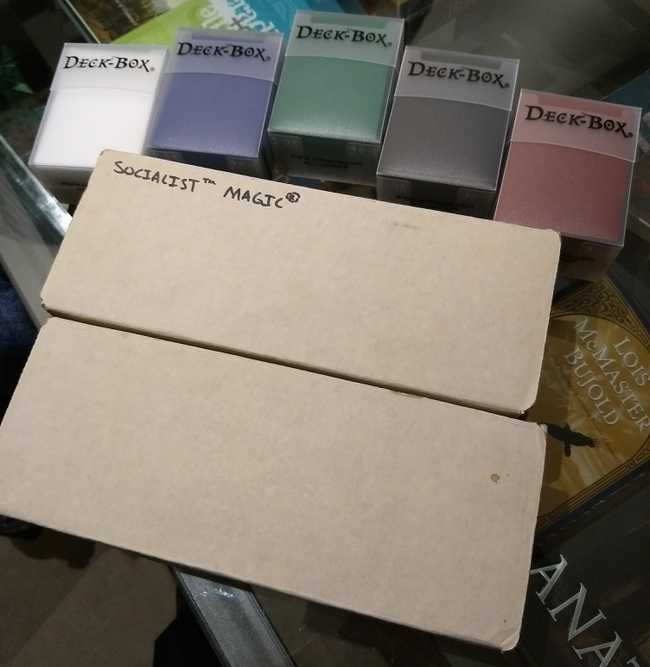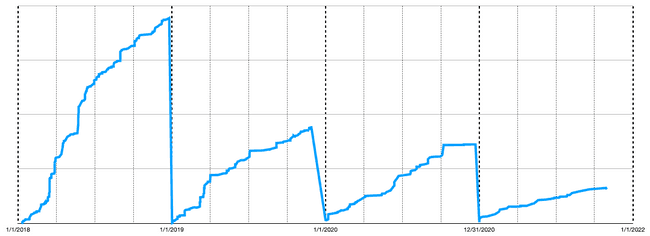Magic: The Gathering
Magic: The Gathering is a fun and amazingly deep game. I have a lot of fun with it. But I went really deep. Probably too deep. Let’s talk about how I got in, and how I took a step back. Maybe you can learn from my story, as well as my recommendations for beginners!
Early leanings
In 1995, when I was a freshman in high school, two collectible card games were vying for dominance: Magic: The Gathering, and Star Wars: Customizable Card Game (SWCCG). Before I got into SWCCG, I remember playing with my friends’ Magic cards, Prodigal Sorcerer among many other classics. But my parents thought Magic went against their beliefs. And so, it became something I only saw from afar, played alongside me and my SWCCG cards in the back of the card shop.
I got a chance to dig in a few years later. Away from my parents in San Luis Obispo for college, I used some of my meager student funds to buy bulk packages of cards, and even a few pristine packs to rip open. We only had a small, communal collection (“Socialist™ Magic®”), but my roommates and I played regularly - usually single-color decks with no artifacts to reduce the competition for any card that could be shared. Occasionally we’d do something special, and cannibalize those decks to make two-color combinations.
By my Junior year of college, Magic was largely forgotten.
Several years later, I started playing board games with my Microsoft colleagues (like Ticket to Ride and Settlers of Catan), and the topic of Magic came up. I dug my old boxes out of the closet, brought them to the next event, and realized that I was way out of my league. At that point, Magic felt like something I’d never dig into.
Finally giving in
It was late 2017, and I had been talking about my SWCCG cards for a few years now. But that discussion mostly seemed to bring up Magic with my friends. It was a better game, they said, with a more elegant design. They were waiting for me to join in and play!
The stage was set.
The fateful moment was Christmas 2017. My partner got me a ready-to-play Magic product: Duel Decks: Merfolk vs. Goblins. It felt familiar, given my previous experience - the basic rules hadn’t changed. We played the two decks against each other a few times, and it really whetted my appetite!
From there, I bought more prebuilt decks, sleeves, deck boxes, even a large 4000-card bulk package from EBay like the days of old. The sorting was quite familiar! When I realized that dinosaurs were actively being printed in the latest sets, I also picked up Ixalan and Rivals of Ixalan packs from Card Kingdom, my local game store here in Seattle.
It felt good to crack packs and explore a new world. Many thousands of cards had been released since I last played! And it was so satisfying - each deck was like a little program, and there were so many decks to build!
But most importantly, lots of people were actively playing. Unlike SWCCG, a huge amount of Magic content was being released every week on YouTube. Stores were regularly holding Magic events. And a friend was continuing to encourage me, giving me more duel decks, loose cards from recent pack-opening, and finally, two full Commander decks: Built from Scratch and Guided by Nature.
Finding my formats
If I thought one-on-one 60-card games of Magic were interesting, four-player Commander (also known as EDH) truly sucked me in. I watched a lot of Game Knights, played a few games with friends, and was totally hooked. The format has so many things to love: the swings back and forth in player advantage, big splashy plays, the metagame of the politics between four players, so many potential deck themes to explore, and even the high variance between games due to a maximum of one copy of each card in the deck.
The decks were still programs, but bigger: 100-card singleton decks. Everything was a lot more exciting!
After playing a little with the decks I had been given, I bought my first two commander decks (Vampiric Bloodlust/current version and Draconic Domination/current version) and started tweaking. It was engrossing, exploring the 20-thousand card back catalog! And there were so many resources available online! Gatherer then Scryfall, mtgsalvation, edhrec, and even YouTube with full deck techs.
Not long after, I built my first Commander deck from scratch. Yes, it was dinosaurs again.
Thanks to The Professor of the Tolarian Community College channel on YouTube, I also found a good format for the one-on-one games I was still playing: Pauper. Like Commander, it has an immense card pool available including all cards printed since 1993, and no rotation. Lack of rotation means you can make a deck and continue to play it over a long period - unlike Standard, which forces you to heavily change or even abandon decks every year.
Pauper’s key limitation is that each card needs to have been printed at the common rarity at some point. This means that even top-tier decks are less than $100! The rest is normal: 60-card decks, a maximum of four copies of any land which isn’t basic.
I had a plan. Commander as much as possible, three to five people per game. For one-on-one games, mostly Pauper. Some Sealed and Draft too, but mostly for special occasions.
An arc of addiction
By the end of 2018 I had 15 Commander and 15 Pauper decks built. I had explored Eldrazi, Ninjas, made a strange coin-flipping deck, and discovered my love of tokens.
By the end of 2019 I had 25 Commander and 21 Pauper decks built. My Pauper battle box covered most of the top decks in the Pauper metagame. I had explored mono-color Commander, making a deck of each color.
Finally, in early 2020 I slowed down, stopping at 30 Commander decks. It was at that point I considered my Commander collection done - after I had made a final expansion into themes and color combinations I hadn’t previously covered, like Gruul X-spells, Orzhov life manipulation, and Dimir Mill.
I put a lot of time and effort into these decks. Analyzing and optimizing, then studying new cards as they were released to see if they applied to any of my decks.
And of course, I wrote code to help me manage my collection, to inventory cards, fetch prices and card images, diff decks to generate a change history, and much more.
It was an endless cycle.
Nearly.
The key to ending it was to figure out how much was ‘enough.’ How many decks can I really play in the span of one year? If I modify even half of my decks with each new set release (5-7 times per year), can I play each of those decks often enough to guarantee that I play the new cards? Are the new cards added to my decks even increasing the fun I have?
It was important to determine ‘enough’ because Magic is expensive: both in time and money. The time I spent with Magic was one of the big reasons I’ve posted so little on this blog since 2017. And I have my spreadsheets tracking spending - despite the existence of a whole community of people using Magic cards as speculative investments, I really felt the need to reduce my spending over time, not increase it. I’d like to think I’ve done a reasonable job:
Magic in the time of quarantine
COVID was particularly frustrating for my Magic aspirations. It’s an in-person game, often played in communal spaces often with total strangers. In March 2020 I had just gotten to a really good stopping point with my deck collection, and was playing Commander with a regular playgroup for the first time.
It took me a while to figure out how to operate in this new environment. My playgroup disbanded; we hadn’t built up enough momentum to justify the effort to try to continue playing into the quarantine.
First, I went deep into Magic: The Gathering Arena, since it was an easy way to get my fix. It helped to distract from all the bad news. But I quickly learned that like paper Magic, it was going to be very expensive to play. And unfortunately it was worse: unlike the normal magic ecosystem, you can’t buy individual cards. There is no such thing as budget brews, unless they use zero rares. In Arena, wildcards of a specific rarity are required to get cards of the matching rarity - and as you might expect rare and mythic wildcards are quite difficult to procure since you can’t directly buy them!
But I decided to fully engage with it. I played Draft quite heavily, trying to get as efficient as possible in my collecting. Once I finished collecting Zendikar Rising, I had a copy of every card in standard. I could make any deck!
But over the next few months I realized that it felt like work - I had daily quests and daily win quotas, and achieved them. During quick draft availability, I needed to do a lot of drafting, as in two or more drafts per day! It was stressful, and I wasn’t even trying to climb the competitive ladder.
The key was a missing component of Magic - The Gathering. Arena doesn’t have any of the social interaction an in-person game would. And it doesn’t support multiplayer formats, my preferred approach. What’s more, even if I did pull a friend in to play one-on-one in Arena, they’d have to go through the same grind I did to get the cards! I lend decks to friends all the time, and this concept doesn’t exist in Arena!
Getting to a good rhythm
In early 2021 I kicked the Arena habit after a friend invited me to play a board game on Tabletop Simulator. I saw how well it replicated the experience of playing Betrayal at House on the Hill with my friends, and quickly found Steam Workshop plugins which imported Magic decklists and provided a familiar playing surface.
This was it! With my decks imported, it was a faithful replication of what it felt like playing with my friends. Just like when they would come over and play with my decks, I could invite them to the simulator, host a game, and virtually hand them my decks. We could chat over the game, and focus more on fun than the win!
It was a turning point for me in the quarantine, honestly. I felt like a bit of normalcy had returned. Four-player and one-on-one games, with the feel of just a table, some dice, and the cards.
By the end of 2021 I was in a good place. I was no longer part of the MTG hype cycle, with new cards being previewed all the time. I wasn’t buying many new cards because my decks were all in good shape. But I was playing with my friends.
It was a sustainable rhythm, finally. The culmination of a process starting in early 2018.
Recommendations for getting into Magic
Maybe you’re interested in playing some Magic? Let me give you the advice I wish I had when I was first getting started.
To start, Game Knights is really fun to watch, yes, but it’s quite a shock to realize that the decks featured are really expensive! It’s not uncommon to see original dual lands played, each over $300. Maybe you can work up to that eventually, but you really don’t need decks like those to have fun!
I think you should start here:
- Magic: The Gathering Arena - If you’re a true beginner, it’s useful to cover the basics of the rules and mechanics. Just don’t spend money on packs or bundles! Don’t get sucked into the daily grind. Get up to speed with the rules and get out!
- Card Kingdom Battle Decks - These are $10 each and give you a great taste of basic magic gameplay and deck synergies. Get two and play them against each other with your friends and family, and expand from there. With 10 of these, you already have 45 different potential one-on-one combinations!
- Preconstructed Commander decks - These are official Magic products which can cost as little as $16, and are playable right out of the box. You can play them one-on-one too, though they are designed for multiplayer. These are pretty low-power.
- Commander’s Quarters - This YouTube channel regularly posts deck videos showing powerful and fun Commander decks available for as low as $25. These are higher-power.
- Buy singles! - There’s a temptation to give into the gamble - you might open expensive cards in your booster packs, and you might get what you want! Don’t do it. Don’t buy booster boxes or packs unless you explicitly plan to Draft. Instead, buy singles. All the major card sellers have extensive singles in stock and easy single/multi-search: Card Kingdom (deck builder), TCGPlayer (mass entry), and Channel Fireball (multi-card search)
- Jumpstart - if you really want the feeling of opening packs, and you’re pretty new, this is a ready-to-play booster box. One booster box comes with 24 packs. Open two packs, shuffle them together, and you have a deck you can play! And if you keep the packs together, you can come back and re-play with new pack combinations for a totally new experience.
- For deck boxes, sleeves, and playmats the The Professor of Tolarian Community College has a great consumer-focused perspective on most Magic products. He’s also got a great set of tutorials for beginner and intermediate players.
Once you do start, momentum builds. It’s easy to go too deep in collecting by yourself, or with others via an arms race. Set expectations and set budgets.
And remember there’s a massive card pool - limitations foster creativity, and you cannot and should not try to collect everything.
Lastly, experiment in low-cost ways (borrowing decks, proxying cards, budget decks) before making big purchases. Yes, you can trade or sell unwanted cards, but it’s a lot easier not to buy them in the first place!
Balance
There was a long while where Magic crowded out all of my other hobbies and interests. With that over, I feel really good that I’ve started blogging again, updated my open-source libraries, jumped back into my SWCCG coding, and have started learning Rust.
But I’ve definitely still got time to play, on Tabletop Simulator and the occasional in-person event (when it’s safe). Do you play Commander? Maybe it would be fun to play!
Let me know!
Six years with Tarot 2022 Feb 06
It might surprise you to learn that I’ve been doing daily Tarot for six years! Unlike my other card collections, which encourage strategic and analytical thought, Tarot pushes you to listen to your... Read more »
Take breaks (Dev productivity tip #6) 2021 Dec 12
I’ve been told that I’m a very productive developer. And it’s not magic; it’s a set of skills you can build! Welcome to the sixth in my developer productivity tips series: Take breaks. I’ve spoken... Read more »



